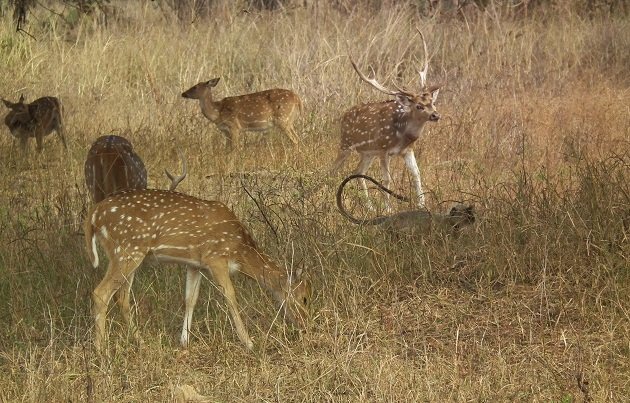
Maharashtra, February 2013
In front of us, in the Tadoba Andhari Tiger Reserve one wild Grey Junglefowl runs across the road. It is one of the ancestors of domestic fowl. Traveling the rural Maharashtra on previous days, every village had its share of small, slim and long-legged domestic chickens crossing in front of us, not unlike this wild cousin at all. Nowhere in India have I seen broiler horror-chicken like those sold in supermarkets back home. I cannot remember when was the last time I ate such tasty chicken before this trip… I actually can: when my grandmother was keeping them for her first grandson. That is how we started to eat chicken in the first place: our ancestors kept the real chicken and got accustomed to the taste. If anyone tried to sell them the horror-chicken, there is no chance they would ever have bought it – such shopping requires growing up in front of TV screens.
The morning is cold, much colder than we expected. Beside the well prepared driver and guide, we are all underdressed for such fast driving in an open Maruti Gypsy. Unlike most of the Indian reserves, Tadoba has a network of paved roads where drivers go up to 60 km/h (37 mi/h), despite the speed limit of a mere 20 km/h (13 mi/h). But if they obeyed the rules, which may be too strict – in the Kruger Park in South Africa, the limit is 50 km/h (31 mi/h) – they would not manage to show tourists much of the reserve in about three hours in the morning and the afternoon, which would reflect on their tip.
A sounder of Indian Boars is watching us from the jungle. They belong to a long-maned subspecies Sus scrofa cristatus (like four-legged Greco/Roman crested helmets) and are my second race of boar seen in India, while I still remain the only Serbian birder who has never seen one closer to home! But this jungle is not how you imagine it would be, something hot and humid; it is a predominantly Southern tropical dry deciduous forest. My Indian friend explained that “jungle” in Hindi stands for “forest”, any forest. Oh? So the word jungle originates in Hindi? No, it originates in English, from where it entered Hindi and got a broader meaning… like a widened state of mind. Good to know.
The tropical dry deciduous jungle, or “jungle”, however you see it, covers almost 90% of 600 km2 (230 mi2) of this protected area. It is dominated by Burmese Teak, interspersed by thickets of Calcutta Bamboo. Other species I can recognize are colloquially called crocodile bark tree, due to the bark pattern, and paper bark. For you and me, there are about 200 bird species, but for proper tourists, there seem to be only five species in the reserve: Bengal Tiger, Leopard, Sloth Bear, Indian Wild Dog (Dhole) and the Gaur.
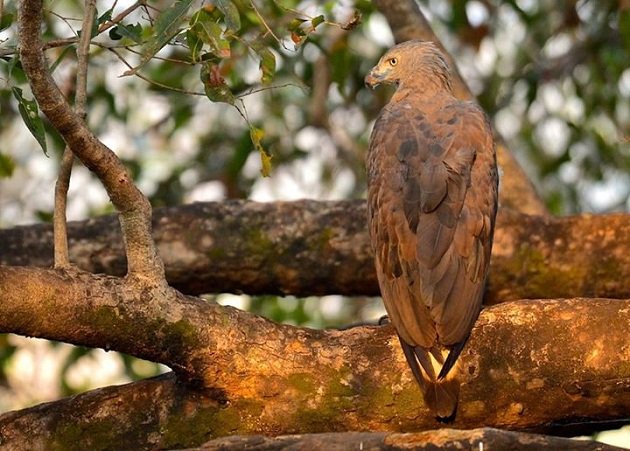 Grey-headed Fish Eagle Copyright © Nitin Bhardwaj
Grey-headed Fish Eagle Copyright © Nitin Bhardwaj
In the north of the reserve, by the Tadoba Lake, a herd of Chital Deer is grazing, with a familiar sight of Cattle Egrets around them. One Chital is curiously watching us. At the lakeshore, Asian Openbill Storks are foraging, while on a low branch of a large tree shadowing the water one massive and upright Grey-headed Fish Eagle stands. On the other side of the road is one tall and almost white paper bark tree, with its bark peeling off like the pages of an open book. There is something written on those pages… written by tiger claws. One-eyed has marked his territory. And we are in it.
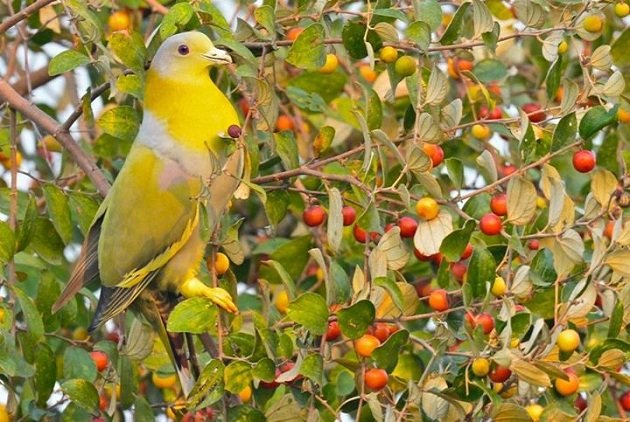 Yellow-footed Green Pigeon Copyright © Nitin Bhardwaj
Yellow-footed Green Pigeon Copyright © Nitin Bhardwaj
There is a glossy blue-black Oriental Magpie-robin in a dusty bush by the road crossed by the Red Spurfowl, while a Yellow-footed Green Pigeon is scrutinising us from a tall branch. This pigeon is the national bird of Maharashtra and remains so after the officials rejected the proposal by conservationists that the rare and endemic Forest Owlet, found only in this state and nowhere else in the world, should replace the pigeon that inhabits the entire India, Pakistan and Afghanistan. A Mugger Crocodile swims in the middle of the lake, while at the jungle edge three Sambar Deer rise and walk away as we approach. One of them has a scarred shoulder, claw marks, but not big enough for Tiger – probably a Leopard.
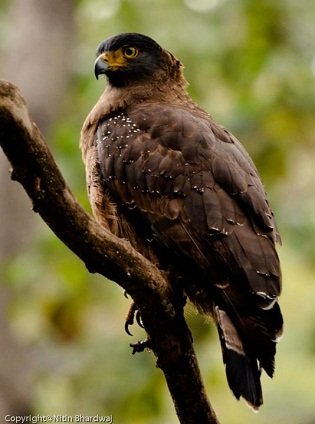 Crested Serpent Eagle Copyright © Nitin Bhardwaj
Crested Serpent Eagle Copyright © Nitin Bhardwaj
Maybe a mile down the road, by the several dozen metres long waterhole, Chitals are grazing (cover photo), Hanuman Langurs are enjoying the acacia shade and, at the far bank, a sounder of those Greco/Roman boars are digging up roots and tubers, earthworms and molluscs. Next to them are White-breasted and Common Kingfishers, while Cattle Egrets are spread among both deer and pigs. Barn Swallows are chasing insects low above water… and there’s a head of a croc hiding in it! At the nearest tree is a Black-rumped Flameback woodpecker, and higher, from the treecrown, a Crested Serpent Eagle is keeping an eye on all comings and goings.
On our way back, our guide notices a shadow in the bamboo and tells the driver to reverse. Among the bamboo, only a few metres away from us, is an imposing black shadow of the largest wild bovid alive today: Gaur! Bigger than the African Buffalo or the American Bison, it is the largest land animal after the Elephant, Rhino, the Hippopotamus and the Giraffe. This is a large male and they can reach up to 220 cm (7 ft 3 in) at the shoulder height and an average weight of 1,000 kg (2,200 lb), occasionally up to 1,500 kg (3,300 lb). He is moving slowly, browsing the bamboo shoots, allowing me to see only a part of its body at any given moment. Huge black head with a white hat, strong horns… slowly disappear in the thickets.
Find the other stages of the same tour here:
Melghat Tiger Reserve: The Search for the Rarest Owl of India


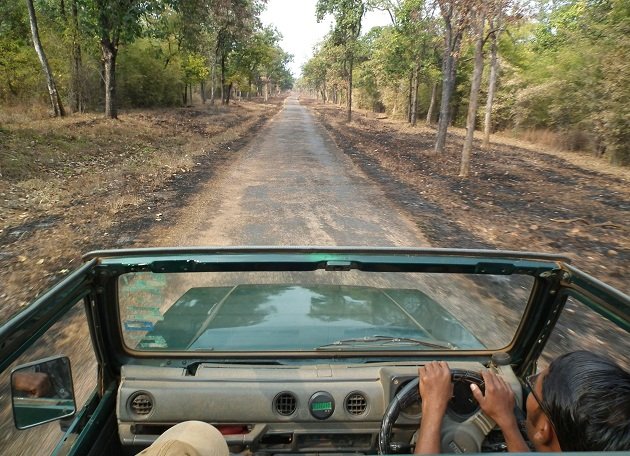











I can’t recommend Tadoba highly enough if people want to see Indian wildlife including Tiger. Much less chaotic and crowded than elsewhere and a really good chance at sloth bear (we got one in our opening 20 minutes) and of course those wonderful grey junglefowl…..
And I cannot agree more 🙂
Bears and tigers will be covered in the part two if this blog
Thanks for reporting on what sounds like a super cool place to experience.
One more amazing sight was a large swarm of fireflies in the night, low above the lake near the guest house. I don’t remember ever seeing such a large swarm (perhaps when I was very young and visiting my grandmother’s farm, but then, the pesticides came in full swing).
And I came to India. To see fireflies, in numbers that might be described somewhere by poets of the old, Walt Whitman perhaps…
This is second time i am reading your blog and first time going to comment. During my journey I had taken 12 tigers photos but not any birds. I loved green Pigeon that you have nicely captured in your camera. Thanks for fantastic photos.
Thank you, Pravakar, but the author of that photo is my friend Nitin Bhardwaj who organised the whole tour. The other parts of the same tour are described here (before)
http://10000birds.com/the-search-for-the-rarest-owl-of-india.htm
And here (after)
http://10000birds.com/tadoba-andhari-tiger-reserve-the-tiger-afternoon.htm